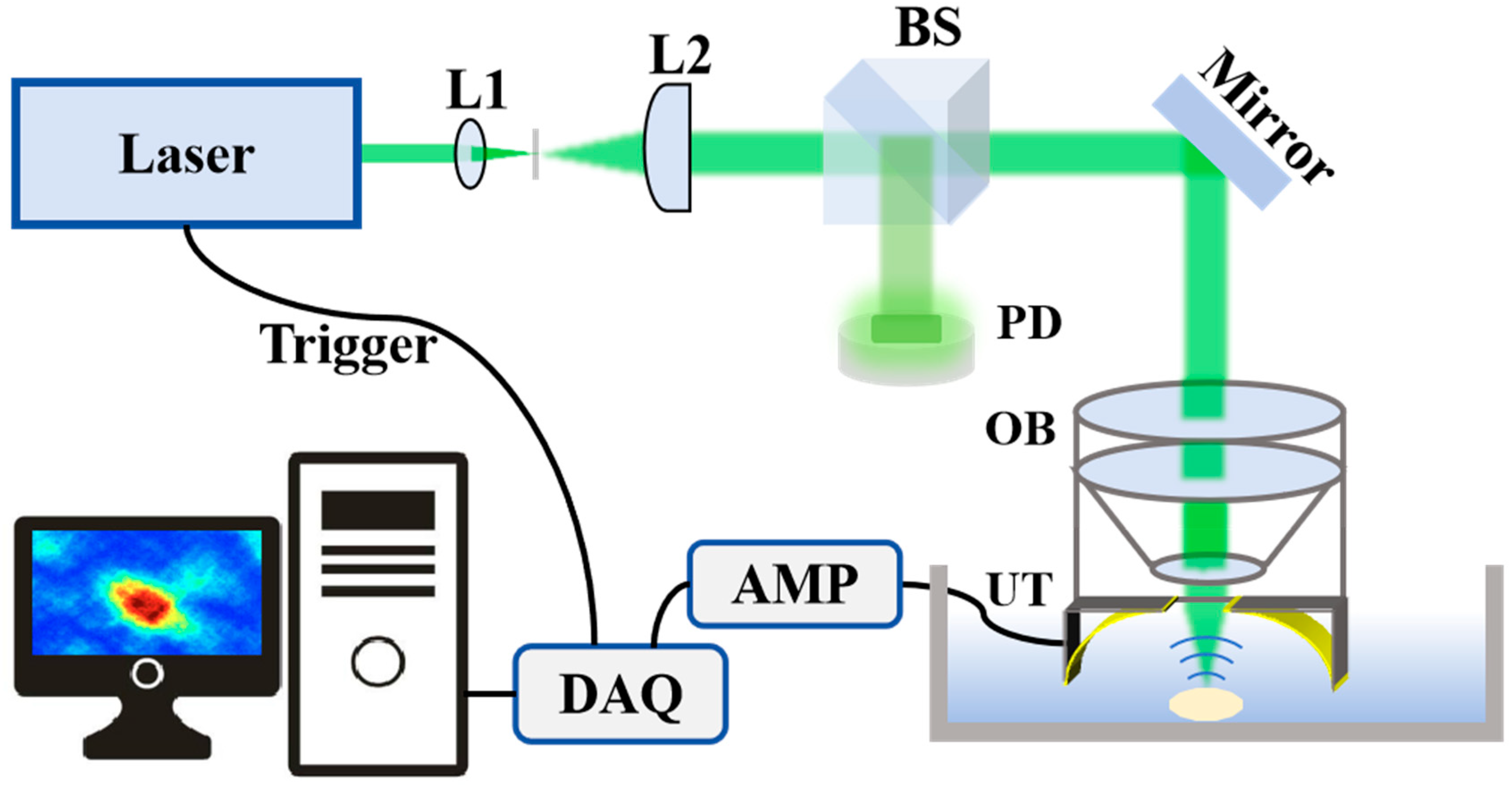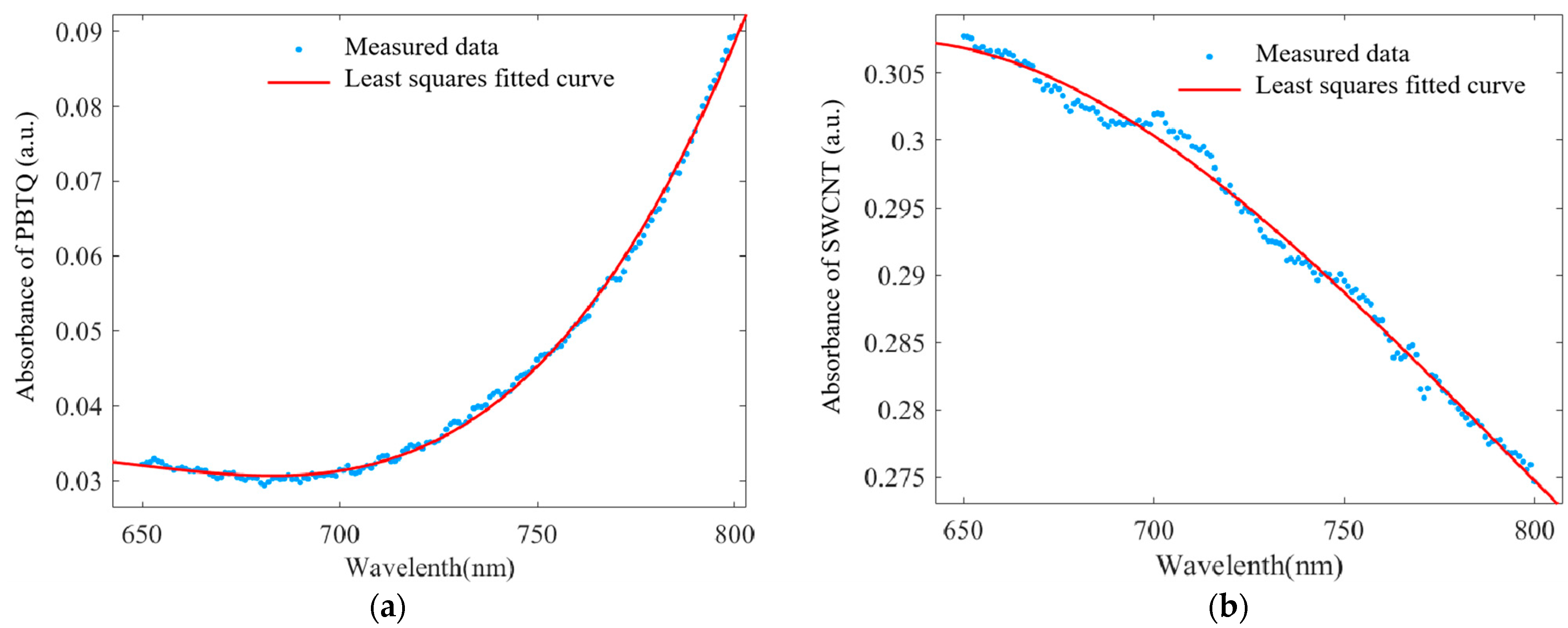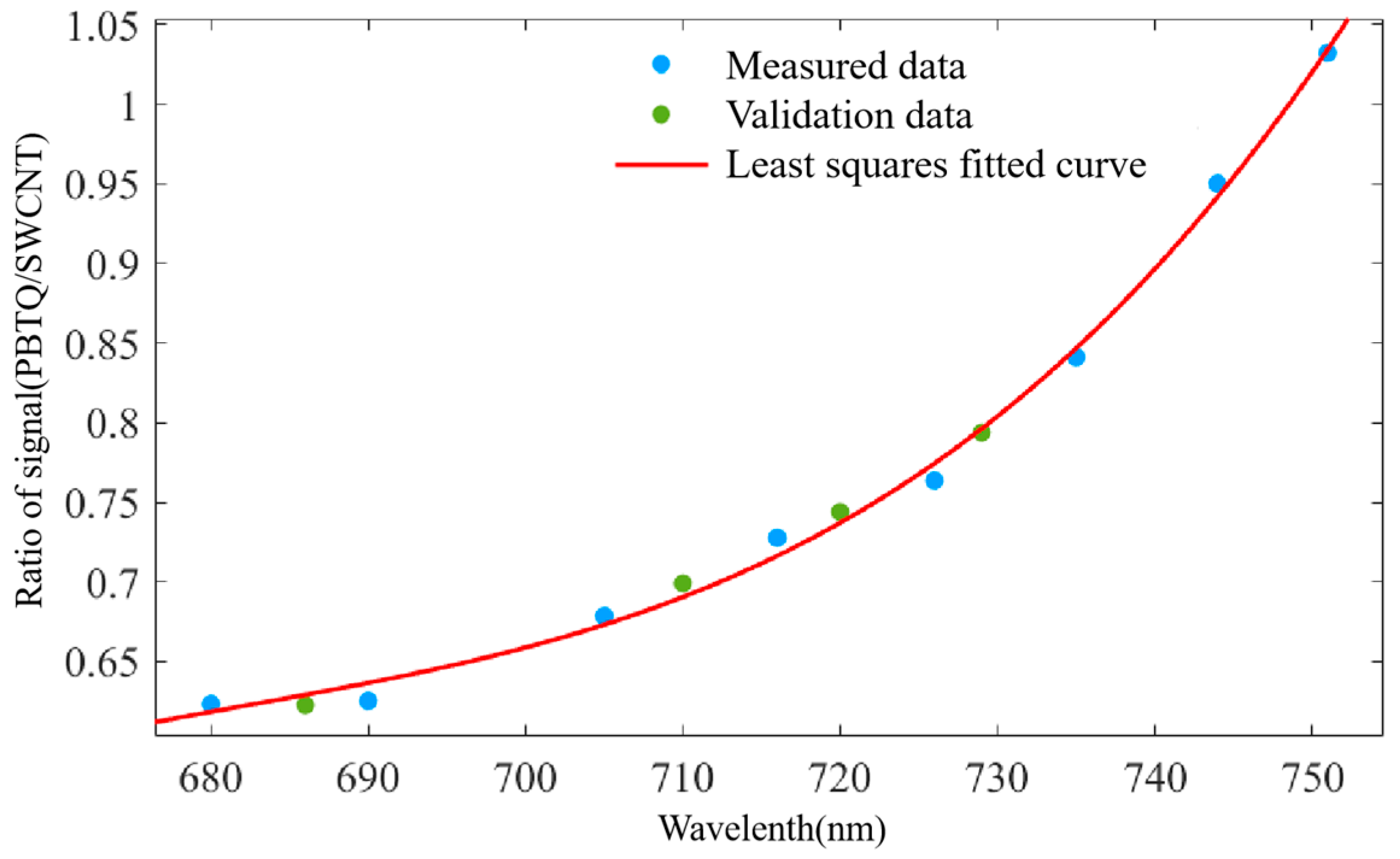A Novel Electromagnetic Wavelength Measurement Method Based on Photoacoustic Effect and Photoacoustic Response Characteristics of Nanomaterials
Abstract
:1. Introduction
2. Methods and System
3. Results and Discussion
4. Conclusions
Author Contributions
Funding
Institutional Review Board Statement
Informed Consent Statement
Data Availability Statement
Conflicts of Interest
References
- Abreu, M.; Candan, G.; Failache, H. Wavemeter. An instrument to determine coherent light beam wavelength. In Proceedings of the IEEE Instrumentation & Measurement Technology Conference, Waltham, MA, USA, 21–23 May 2002. [Google Scholar] [CrossRef]
- Solomakha, D.A.; Toropov, A.K. Laser wavelength measurements (review). Sov. J. Quantum Electron. 1977, 7, 1637–1660. [Google Scholar] [CrossRef]
- Coddington, I.; Swann, W.C.; Newbury, N.R. Erratum: Coherent Multiheterodyne Spectroscopy Using Stabilized Optical Frequency Combs. Phys. Rev. Lett. 2008, 100, 013902. [Google Scholar] [CrossRef]
- Cao, T.L.; Yao, J.Q.; Zheng, Y. Ways of wavelength mesasurement of terahertz wave based on Fabry-Perot interferometer. Opt. Instrum. 2008, 30, 13–16. [Google Scholar]
- Das, D.; Banerjee, A.; Barthwal, S.; Natarajana, V. A rubidium-stabilized ring-cavity resonator for optical frequency metrology: Precise measurement of the D1 line in 133Cs. Eur. Phys. J. Dat. Mol. Opt. Plasma Phys. 2006, 38, 545–552. [Google Scholar] [CrossRef]
- Qi, X.; Xiao, H.; Han, X.; Xia, D.; Chen, X. Frequency Measurement for Terahertz Waves Based on High Magnetic Field Technology. In Proceedings of the 44th International Conference on Infrared, Millimeter, and Terahertz Waves (IRMMW-THz), Paris, France, 1–6 September 2019. [Google Scholar] [CrossRef]
- Yee, D.S.; Jang, Y.D.; Kim, Y.C.; Seo, D.C. Terahertz spectrum analyzer based on frequency and power measurement. Opt. Lett. 2010, 35, 2532–2534. [Google Scholar] [CrossRef]
- Zou, X.; Yao, J. Microwave frequency measurement with improved measurement range and resolution. Electron. Lett. 2009, 45, 497–498. [Google Scholar] [CrossRef]
- Lau, K.Y.; Nabiev, R.F.; Chang-Hasnain, C.J.; Eng, L.E. Spectrodetector: Novel monolithic wavelength reader and photodetector. Electron. Lett. 2002, 31, 1373–1374. [Google Scholar] [CrossRef]
- Badran, H. A Low Cost Instantaneous Frequency Measurement System. Electromagn. Res. M 2017, 59, 171–180. [Google Scholar] [CrossRef]
- Xu, C.; Zhang, Y.S.; Zhao, Y.S.; Li, P. Advances in Spectroscopic Characters of Space Objects. J. Clin. Otorhinolaryngol. 2017, 37, 672–678. [Google Scholar]
- Ivanov, A.A.; Morozov, O.G.; Andreev, V.A.; Morozov, G.A.; Faskhutdinov, L.M. Microwave photonic system for instantaneous frequency measurement based on principles of “frequency-amplitude” conversion in fiber Bragg grating and additional frequency separation. In Proceedings of the XIV International Scientific and Technical Conference on Optical Technologies in Telecommunications, Samara, Russia, 23–26 November 2016; International Society for Optics and Photonics: San Diego, CA, USA, 2017. [Google Scholar] [CrossRef]
- Dai, J.; Xu, K.; Duan, R.; Zhang, X.; Wang, D.; Wu, J.; Lin, J. Instantaneous frequency measurement based on complementary microwave photonic filters with a shared Mach–Zehnder interferometer. Opt. Commun. 2011, 284, 5738–5741. [Google Scholar] [CrossRef]
- Thattey, S.S.; Dongare, A.S.; Dasgupta, K.; More, S.R.; Nair, L.G. A wavemeter for measuring changes in wavelength of pulsed dye lasers. Rev. Sci. Instrum. 1994, 65, 2470–2474. [Google Scholar] [CrossRef]
- Saitoh, T.; Nakamura, K.; Takahashi, Y.; Miyagi, K. Optical spectrum analyzer utilizing MEMS scanning mirror. IEEE Photonics Technol. Lett. 2006, 18, 767–769. [Google Scholar] [CrossRef]
- Petley, B.W.; Morris, K. A simple CW laser digital wavemeter. Opt. Quantum Electron. 1978, 10, 277–278. [Google Scholar] [CrossRef]
- Karpowicz, N.; Dai, J.; Lu, X.; Chen, Y.; Yamaguchi, M.; Zhao, H. Coherent heterodyne time-domain spectrometry covering the entire “terahertz gap”. Appl. Phys. Lett. 2008, 92, 011131. [Google Scholar] [CrossRef]
- Ach, F.; Schmiedel, A.; Kaemling, A.; Fischer, C.; Viöl, W. High power infrared laser beam monitoring by optical measurement of mirror surface deformation. Laser Phys. Lett. 2010, 2, 267–271. [Google Scholar] [CrossRef]
- Zhang, B.; Peng, Z.; Xia, Y.; Sun, Z.; Zheng, K.; Zhu, Q.; Dong, J.; Lu, Z. High precise time division multiplex UV pulse waveform measurement system for high power laser facility. Fusion Eng. Des. 2021, 173, 112878. [Google Scholar] [CrossRef]
- Liu, Y.; Liu, J.F.; Chen, D.D.; Wang, X.S.; Zhang, Z.; Yang, Y.C.; Jiang, L.H.; Qi, W.Z.; Ye, Z.Y.; He, S.Q.; et al. Fluorination Enhances NIR-II Fluorescence of Polymer Dots for Quantitative Brain Tumor Imaging. Angew. Chem. Int. Ed. 2020, 132, 21235–21243. [Google Scholar] [CrossRef]
- Wang, W.P.; Huang, L.; Zhou, H.J.; Gong, S.; Zeng, H.X.; Zhou, J.; Yang, Z.Q.; Zhang, Y.X. Low Frequency Terahertz Induced Thermoacoustic Signal Characteristics and Its Application in Solid-State Terahertz Transmitter Power Detection. IEEE Trans. Terahertz Sci. Technol. 2022, 12, 673–677. [Google Scholar] [CrossRef]
- Satapathy, A.; Sawant, K.K.; Mondal, S.; Raj, A.A.B.; Mahimkar, K.; Kandasubramanian, B. Recent Progress on MXenes as an Attenuator of Terahertz Radiation. J. Electron. Mater. 2023, 52, 1749–1768. [Google Scholar] [CrossRef]
- Titova, L.V.; Li, G.; Natu, V.; Huang, S.; Barsoum, M.W. 2D MXenes: Terahertz Properties and Applications. In Proceedings of the 45th International Conference on Infrared, Millimeter, and Terahertz Waves (IRMMW-THz), Buffalo, NY, USA, 8–13 November 2020. [Google Scholar] [CrossRef]
- Yang, Y.Y.; Gong, P.; Ma, W.D.; Hao, R.; Fang, X.Y. Effects of substitution of group-V atoms for carbon or silicon atoms on optical properties of silicon carbide nanotubes. Chin. Phys. B 2021, 30, 67803. [Google Scholar] [CrossRef]
- Henaish, A.; Abouhaswa, A. Effect of WO3 nanoparticle doping on the physical properties of PVC polymer. Bull. Mater. Sci. 2020, 43, 149. [Google Scholar] [CrossRef]



| MATERIAL | SSE | RMSE | |
|---|---|---|---|
| PBTQ | 0.998 | 8.016 × 10−5 | 7.385 × 10−4 |
| SWCNT | 0.9942 | 1.111 × 10−4 | 8.694 × 10−4 |
Disclaimer/Publisher’s Note: The statements, opinions and data contained in all publications are solely those of the individual author(s) and contributor(s) and not of MDPI and/or the editor(s). MDPI and/or the editor(s) disclaim responsibility for any injury to people or property resulting from any ideas, methods, instructions or products referred to in the content. |
© 2024 by the authors. Licensee MDPI, Basel, Switzerland. This article is an open access article distributed under the terms and conditions of the Creative Commons Attribution (CC BY) license (https://creativecommons.org/licenses/by/4.0/).
Share and Cite
Huang, Y.; Zhong, R.; Zhang, Z.; Huang, L. A Novel Electromagnetic Wavelength Measurement Method Based on Photoacoustic Effect and Photoacoustic Response Characteristics of Nanomaterials. Photonics 2024, 11, 831. https://doi.org/10.3390/photonics11090831
Huang Y, Zhong R, Zhang Z, Huang L. A Novel Electromagnetic Wavelength Measurement Method Based on Photoacoustic Effect and Photoacoustic Response Characteristics of Nanomaterials. Photonics. 2024; 11(9):831. https://doi.org/10.3390/photonics11090831
Chicago/Turabian StyleHuang, Yijie, Renbin Zhong, Zhenhui Zhang, and Lin Huang. 2024. "A Novel Electromagnetic Wavelength Measurement Method Based on Photoacoustic Effect and Photoacoustic Response Characteristics of Nanomaterials" Photonics 11, no. 9: 831. https://doi.org/10.3390/photonics11090831





